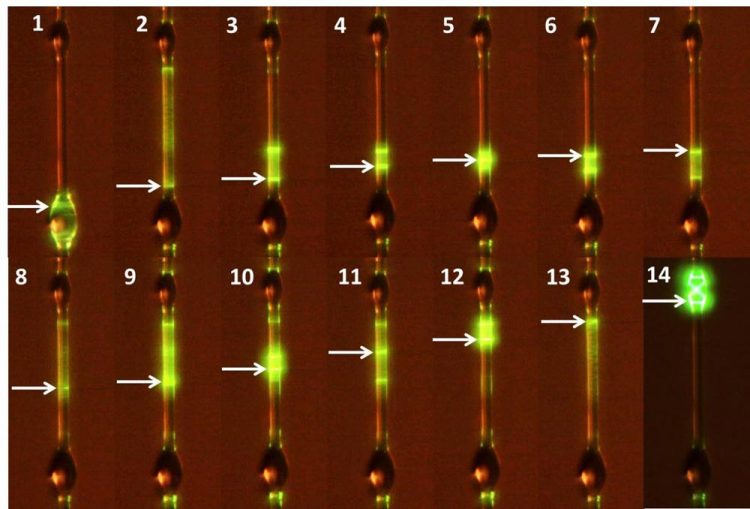New fabrication and thermo-optical tuning of whispering gallery microlasers

A thin coating (around one micron thick) is formed on the capillary. Laser light can be created at almost any point on the capillary, indicated by the white arrow. The thin coating allows for the fabrication of much smaller microlasers. Credit: OIST
Microlasers are tiny optical devices a few tens of micrometres in diameter that are able to create intense light with only one colour or wavelength. OIST researchers found a new method to fabricate a special type of glass microlaser, called whispering gallery microlasers.
Whispering gallery microlasers are doughnut-shaped or spherical devices produced from glass doped with rare earth elements, such as erbium or ytterbium (Er or Yb). Inside the microlasers, light is reflected over and over creating a 10-100 metre long optical path within a tiny device that's the size of a grain of sand.
Taking advantage of the different melting temperatures of silica and Er or Yb doped phosphate glass, OIST scientists have devised a new way to produce microlasers via glass wetting, or glass-on-glass fabrication. In this new technique, a strand of Er or Yb doped phosphate glass is melted and allowed to flow around a hollow capillary of silica.
This is possible because of the different melting temperatures of silica and phosphate glass at 1500°C and 500°C, respectively. This technique produces bottle-shaped microlasers, which are 170 micrometres in diameter. The bottle-shape can then be modified to become a thin coating of only a few micrometres in diameter around the capillary.
While fabricating doped glass microlasers using traditional methods can be tedious, with each individual sphere being attached to a glass strand, this glass wetting technique allows scientists to make any number of microlasers quickly and in series.
This technique also facilitates a new way of tuning the wavelength or colour of light emitted by the microlasers. The tuning is achieved by a combination of pressure and temperature. Compressed gas passed through the capillary cools the walls of the hollow structure. This cooling effect makes the diameter of the microlaser contract, which changes the laser output wavelength.
Microlasers prepared with this new technique were used to measure the air flow in microfluidic devices and have been shown to be more sensitive than commercial electronic flow sensors, as well as 10,000 times smaller.
“We wanted the ability to tune micro-scale lasers without increasing the size and the complexity of the device and keeping high quality,” points out Dr Jonathan Ward, the first author of this study. “This could be a step towards the quick and easy fabrication of smaller devices for biosensing and optical communications.”
Media Contact
All latest news from the category: Physics and Astronomy
This area deals with the fundamental laws and building blocks of nature and how they interact, the properties and the behavior of matter, and research into space and time and their structures.
innovations-report provides in-depth reports and articles on subjects such as astrophysics, laser technologies, nuclear, quantum, particle and solid-state physics, nanotechnologies, planetary research and findings (Mars, Venus) and developments related to the Hubble Telescope.
Newest articles

A universal framework for spatial biology
SpatialData is a freely accessible tool to unify and integrate data from different omics technologies accounting for spatial information, which can provide holistic insights into health and disease. Biological processes…

How complex biological processes arise
A $20 million grant from the U.S. National Science Foundation (NSF) will support the establishment and operation of the National Synthesis Center for Emergence in the Molecular and Cellular Sciences (NCEMS) at…

Airborne single-photon lidar system achieves high-resolution 3D imaging
Compact, low-power system opens doors for photon-efficient drone and satellite-based environmental monitoring and mapping. Researchers have developed a compact and lightweight single-photon airborne lidar system that can acquire high-resolution 3D…





















